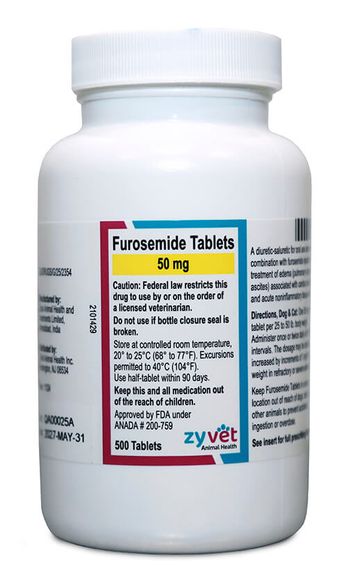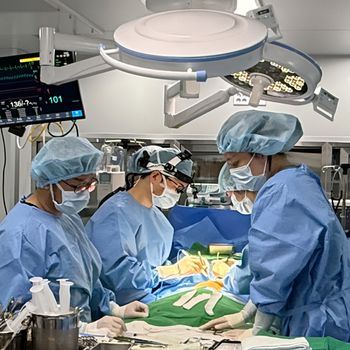
Dyspneic cats: triage and differentiation of cardiogenic versus noncardiogenic causes (Proceedings)
Respiratory abnormalities are relatively common in cats, who may suffer from a wide range of disease processes. An initial triage step in the management of a dyspnic cat is to determine whether the dyspnea is cardiogenic or due to extracardiac (primary pulmonary) disease. This task is in no way a simple one, as cats often have non-specific history and physical examination abnormalities.
Respiratory abnormalities are relatively common in cats, who may suffer from a wide range of disease processes. An initial triage step in the management of a dyspnic cat is to determine whether the dyspnea is cardiogenic or due to extracardiac (primary pulmonary) disease. This task is in no way a simple one, as cats often have non-specific history and physical examination abnormalities. Dyspnic cats are notoriously very fragile patients who can become critically decompensated with too much stress and diagnostic testing. A family history of hypertrophic cardiomyopathy, sudden death, or arterial thromboembolism, or signalment including breeds predisposed to develop familial heritable hypertrophic cardiomyopathy (i.e. Ragdoll, Maine Coon cat, Scottish fold, Turkish Van, Sphynx, Rex, British Shorthair, American Shorthair, and Siberian cat) may raise the suspicion of heart disease. A history of coughing, retching, or wheezing is more consistent with airway disease or primary pulmonary disease than heart failure, since cats with heart failure infrequently cough. Clients should be questioned if they administer monthly heartworm preventative to the cat since heartworm disease is an important cause of respiratory abnormalities in cats.
Cardiovascular examination in cats with heart failure may be non-specific since often heart sounds are masked by adventitious lung sounds or muffled by pleural effusion. Depending on the heart disease present, the incidence of heart murmurs range from high (~60%) in cats with hypertrophic cardiomyopathy, to only 20% of cats with dilated cardiomyopathy. A gallop heart sound (S3 or S4 heart sound) is commonly heart in cats with dilated cardiomyopathy (80%) and invariably present with other heart diseases (33% in HCM). An arrhythmia is invariably present in cats with severe heart disease, and may include premature beats, tachycardia, or irregularly irregular rhythm. Cats with a mediastinal mass have firm, non-compliant chests identified by palpation of the cranial mediastinum.
The respiratory disease can be anatomically localized based on physical examination and thoracic radiographs. Upper airway disease (nasal, pharyngeal, extrathoracic trachea) produces a stridorous breathing pattern with marked increase in inspiratory effort. Lower airway disease involving the bronchioles is extremely common in cats, and produces an expiratory breathing pattern, wheezy pulmonary auscultation, and cough. Pulmonary parenchymal disease causes a mixed inspiratory and expiratory breathing pattern, and includes a wide range of diseases including cardiogenic pulmonary edema, infectious diseases, inflammatory diseases, neoplasia, parasitic lung disease, or pulmonary fibrosis, and can be very challenging to distinguish. Pleural disease (i.e. pleural effusion, pleural fibrosis) produces a restrictive breathing pattern characterized by shallow rapid respirations. Common pathophysiologic processes causing pleural effusion include: increased systemic and pleural capillary hydrostatic pressures (congestive heart failure), decreased plasma oncotic pressure (hypoalbuminemia <1.5 g/dL), increased capillary permeability (inflammation), lymphatic obstruction or dysfunction, infectious causes, trauma, coagulopathy, parasitic (heartworm or aleurostrongylus), and intrathoracic neoplasia.
Initial triage of a dyspnic cat includes a triage thoracic ultrasound to evaluate for significant pleural effusion, which should be immediately removed to stabilize the cat. This can be done with the cat in sternal recumbency with minimal manipulation or restraint. If the cat is fractious or extremely anxious, an opioid +/- low dose acepromazine (0.01 mg/kg) can be given as a sedative. Pleural effusion should be submitted for fluid analysis, which if often non-specific in cats with heart failure, and may include: transudate, modified transudate, pseudochylous, or chylous effusion. An exudate (septic vs. aseptic) is another important cause of pleural effusion in cats and can be identified on fluid analysis. During the triage ultrasound, assessment of atrial size is essential to determine whether the dyspnea is due to severe heart disease or non-cardiac disease. Left atrial size can be quantified by measurement of the left atrial diameter and aortic diameter, and a ratio of LA:AO < 1.5 is normal. Typically cats with heart failure have significantly increased LA:Ao of >1.8. Cats with normal left atrial size and dyspnea do not have congestive heart failure as a cause of the dyspnea. Assessment of left ventricular myocardial function is also important. Athough dilated cardiomyopathy or significant myocardial failure is relatively uncommon in cats (10% of cardiomyopathy cases), it has important treatment implications including avoidance of beta blockers and using pimobendan and possibly digoxin. The anterior mediastinum should also be imaged to assess for a mediastinal mass as a cause of dyspnea and pleural effusion.
Thoracic radiographs are invaluable for assessment of respiratory disease, but should never be a terminal event. Sometimes there are pathognomic pulmonary patterns of bronchial disease, or cats may have obvious cardiomegaly, pulmonary venous congestion, and pulmonary edema. Probably the majority of cats have more ambiguous abnormalities including pulmonary infiltrates, possibly a bronchial pattern, and possibly pleural effusion. Cardiogenic pulmonary edema does not follow a typical pattern of distribution of perihilar to caudodorsal lung lobes, and is most often diffuse. It always includes more than one lung lobe, and is typically asymmetrical. Detection of a lobar consolidation raises suspicion of pneumonia or neoplasia and places heart failure to the bottom of the list. Identification of cardiomegaly and atrial dilation can also be challenging in cats since the left atrium is located more centrally in the lateral radiography. Using subjective assessment, left atrial dilation was only identified in 48- 72% of cats compared to the gold standard of echocardiographic measurement of left atrial size. Often the dorsoventral or ventrodorsal views are most useful to identify atrial dilation, which appear as a valentine shaped heart. Sometimes the heart is obscured by pulmonary infiltrates, and an echocardiogram is essential to assess if there is significant cardiac disease. Pulmonary venous distension is often identified (71%) on radiographs in cats with heart failure. Presence of right heart enlargement, bicavitary effusion, hepatomegaly, and dilation of the caudal vena cava are consistent with right heart failure, with top differentials including dilated cardiomyopathy, tricuspid valve disease, arrhythmogenic right ventricular cardiomyopathy. Often there is a combination of pleural effusion and pulmonary edema in cats with heart disease from many etiologies.
Secondary diagnostic modalities used to refine the cause of dyspnea includes an advanced echocardiogram, computed tomography, bronchoscopy and bronchoalveolar lavage, and additional diagnostic tests such as heartworm antigen and antibody test or fine needle aspirate and cytologic evaluation of a pulmonary or mediastinal mass. An advanced echocardiogram is used to determine the etiology of heart disease present, assess for intracardiac thrombus or spontaneous echocardiographic contrast, and assess for heartworms in the main pulmonary artery and proximal left and right caudal lobar branches. Echocardiography is a specific and relatively sensitive tool in cats for diagnosis of heartworm disease, and is essential in cats that have lower airway disease.
Treatment of congestive heart failure
Treatment of CHF is similar regardless of the specific cardiac disease present, and includes furosemide in the acute setting and an angiotensin converting enzyme (ACE) inhibitor once the cat is at home. Furosemide may be given parenterally (2-4 mg/kg every 1-4 hours) in cats with fulminant CHF, and the furosemide dose should be rapidly tapered once the respiratory rate and effort begin to improve. Although efficacy is unknown, the venodilator nitroglycerin may be applied transdermally (1/4 inch every 6 hours) for 2 days until tolerance develops. Oxygen therapy is necessary in severe cases, and the fractional inspired oxygen percentage should be decreased to 50% or less if possible within 12 hours to avoid further barotrauma. An ACE inhibitor should not be started until the cat is eating, drinking, and not dehydrated, as it may potentiate renal insufficiency in dehydrated cats. Chronic oral dosing of furosemide may be started at 1 mg/kg PO q24 hr- BID and increased over time as the severity of CHF worsens to a maximal ceiling dose of 4 mg/kg PO TID. In cats receiving maximal furosemide doses that have refractory CHF, substitution of subcutaneous furosemide 2 times a week for an oral dose may provide additional diuresis. Some degree of azotemia is expected in cats receiving aggressive diuretic therapy. Addition of another diuretic such as hydrochlorothiazide (1-2 mg/kg PO q24 hr – BID) can be cautiously done, although there is high likelihood of side effects and significant progressive azotemia.
Anticoagulant therapy
Anticoagulant therapy is necessary in cats that have suffered from arterial thromboembolism or who have echocardiographic evidence of spontaneous contrast within the left atrium, and may be considered in cats with moderate or severe left atrial dilation. Aspirin (5 mg – 81 mg PO q 3 days) has relatively underwhelming and variable success in prevention of thromboembolism. In cats that have suffered from arterial thromboembolism, survival with or without thrombolytic therapy is only 30-40%. Recurrence rate with aspirin (standard or low dose) is variable and ranges from 28-90%.1;2 Clopidogrel is a novel anti-platelet agent that irreversibly inhibits ADP receptors on platelet membranes. Clopidogrel has been shown to inhibit platelet aggregation, increase oral mucosal bleeding time, and reduce plasma serotonin concentration in normal cats at doses as low as 18.75 mg PO q 24 hours.3 Low molecular weight heparins (LMWH) such as dalteparin and enoxaparin are attractive alternatives to unfractionated heparin given their increased bioavailability and prolonged half lives. Compared to unfractionated heparin, LMWHs work more specifically upstream in the coagulation cascade against Factor X with much lower activity against thrombin (Factor II). Since there is less anti-II activity, LMWHs do not alter PT and APTT times, and therapeutic efficacy must be assessed by measurement of anti-Xa activity. There are only a few pilot studies evaluating pharmacokinetics of dalteparin and enoxaparin in healthy cats. 1.5 mg/kg of enoxaparin SQ appears to adequately suppress factor Xa activity, but the optimal dosing interval is less clearly defined.4 Dosing frequencies of BID to TID are likely necessary for sustained anti-Xa activity.
Treatment of heartworm associated lung disease
Similar to asthma, the goals of treatment of heartworm associated respiratory disease in cats is to decrease pulmonary and bronchial inflammatory response to the heartworms, bronchodilator therapy, and chemoprophylaxis to prevent additional infestation. Adulticidal therapy is typically contraindicated. Prednisolone is the mainstay of therapy (1-2 mg/kg PO divided BID for 14 days then weaned to the lowest effective dose to control wheezing and dyspnea). An albuterol inhaler is also useful to lessen bronchconstriction. Other bronchodilators to be considered include terbutaline or aminophylline in patients not responding to beta agonist therapy. Often cats require long-term medical therapy, as there is ongoing, sometimes lifelong, inflammatory lung disease. Death of an adult worm may result in a severe respiratory crisis, which is managed with dexamethasone, oxygen, and bronchodilator therapy.
Diagnosis of specific cardiomyopathies and treatment is outlined below.
Hypertrophic cardiomyopathy
Hypertrophic cardiomyopathy (HCM) is the most common heart disease in cats. It is characterized by concentric left ventricular hypertrophy (i.e. increased wall thickness) in the absence of other systemic diseases, such as hyperthyroidism or systemic hypertension, known to cause concentric hypertrophy. HCM has been found to be an autosomal dominant inherited disease with incomplete penetrance in Maine Coon cats. Recently, the sarcomeric mutation responsible for familial HCM in a family of Maine Coon cats was discovered.5 A missense mutation in the sarcomeric protein myosin binding protein C results in a switch in conserved amino acids and alteration in the protein conformation. Other breeds that are predisposed to develop HCM include: American shorthairs, British shorthairs, Ragdoll, Norwegian forest cat, Turkish van, Scottish fold, Siberian, and Rex. Despite several purebred predilections, the most common type of cat diagnosed with HCM is the domestic shorthair (mixed breed) cat. Male cats are more commonly diagnosed with HCM.
Cats with HCM develop concentric left ventricular hypertrophy and myocardial fibrosis that causes diastolic dysfunction. In severe disease, diastolic dysfunction may lead to increased left ventricular filling pressure, left atrial enlargement, and congestive heart failure (CHF). Cats with severe HCM and left atrial enlargement are at risk of a thrombus forming in the stagnant blood pool of the left atrium/auricle. 12-17 % of cats with HCM develop arterial thromboembolism, with a majority of cats (71%) having moderate or severe left atrial enlargement. Sudden death is another sequela to HCM and is likely caused by ventricular arrhythmias secondary to myocardial fibrosis and hypertrophy.
HCM is diagnosed by echocardiographic measurement of the end-diastolic left ventricular wall or interventricular septal thickness of ≥ 6 mm. Hypertrophy may be symmetrical or assymetrical. Papillary hypertrophy may be an early abnormality even when the wall thickness is normal. Systolic blood pressure and serum thyroxine concentration must be measured to rule out secondary causes of concentric left ventricular hypertrophy. Systolic anterior motion (SAM) of the mitral valve should be assessed in the right parasternal long-axis left ventricular outflow tract view using 2 dimensional echocardiography and color flow Doppler. Color flow Doppler depicts two turbulent jets (mitral regurgitation and turbulent blood flow in the left ventricular outflow tract and aorta) arising from the obstruction of the left ventricular outflow tract by the anterior mitral leaflet. Pulsed wave and continuous wave Doppler are performed in the left apical 5- chamber view to measure the aortic blood flow velocity and determine the severity of the SAM. Left atrial size is measured by 2-dimensional echocardiography in the right parasternal short-axis view at the base of the heart. Left atrial to aortic diameter ratio ≥ 1.5 identifies left atrial dilation. Evaluation of spontaneous contrast of red cell aggregation or thrombus formation in the left atrium is also important. Diastolic dysfunction may be assessed using pulsed wave Doppler of the mitral inflow and pulmonary venous flow. Delayed relaxation or restrictive patterns may be identified which denote worsening stages of diastolic dysfunction respectively. However, there is an intermediate flow pattern termed "pseudonormalization" which may mask diagnosis of diastolic dysfunction. Tissue Doppler imaging (TDI) echocardiography is useful to detect diastolic impairment, which is evidenced by reduced early diastolic myocardial velocities of the left ventricular free wall in short-axis or reduced lateral mitral annular velocity in the left 4-chamber apical view. Pulsed wave TDI or color TDI are both used to assess regional or global myocardial function.
Treatment of asymptomatic cats is debatable. The same scenario exists in human medicine, and treatment of asymptomatic people is on an "empiric basis without controlled data to either support or contradict is potential efficacy". One treatment goal is to reduce left ventricular hypertrophy. Beta blockers and calcium channel blockers have anecdotally been shown to reduce hypertrophy is some cats. Only one small, unblinded, uncontrolled study has evaluated the effect of diltiazem on left ventricular hypertrophy and diastolic function in 12 cats.6 Diltiazem reduced left ventricular hypertrophy and improved left ventricular relaxation time over the 6 months of therapy. Angiotensin converting enzyme (ACE) inhibition has been shown to reduce left ventricular hypertrophy in 2 small, uncontrolled or retrospective studies, where LV hypertrophy was assessed by either M-mode or 2-dimensional echo.7;8 However, 2-dimensional echocardiographic assessment of hypertrophy is fraught with high inter-and intraobserver variability of 18-20% respectively. The author completed a double blinded, placebo controlled, randomized, prospective study evaluating the effect of ramipril on left ventricular mass, diastolic function, neurohormones, and blood pressure in 26 Maine coon and Maine coon-cross cats with mild to severe familial HCM without CHF.9 Left ventricular mass was quantified by cardiac magnetic resonance imaging, diastolic function was assessed by pulsed wave TDI, and plasma concentration of aldosterone and brain natriuretic peptide were measured. There was no difference in left ventricular mass, diastolic function, delayed contrast enhancement assessment of myocardial fibrosis, blood pressure, or neurohormones between the placebo and ramipril treatment groups.
Recently, the author completed a small, double blinded, placebo controlled prospective study evaluating the effect of spironolactone on diastolic function assessed by TDI and on left ventricular mass quantified by echocardiography. 26 Maine Coon cats with familial HCM without congestive heart failure were included in the study. All cats had diastolic dysfunction at baseline. Cats were given 2 mg/kg PO BID of placebo or spironolactone for 4-months, and echocardiography was performed every 2 months. There was no difference in diastolic function or systolic function assessed by TDI, left ventricular mass, or left atrial size. Serum aldosterone concentration was markedly elevated in cats treated with aldosterone. Approximately one-third of cats given spironolactone developed severe facial ulcerative dermatitis, which may have been causes by a drug reaction.
A second treatment goal in cats hypertrophic obstructive cardiomyopathy (HOCM) is to reduce the severity of SAM if it is moderate or severe. Beta blockers and calcium channel blockers have been used to reduce SAM. Based on a small pilot study of intravenous esmolol versus intravenous diltiazem, it appears that beta blockers may be more effective in reduction of SAM. There is no evidence that reduction of SAM improves overall survival in cats.
Treatment of congestive heart failure includes furosemide and angiotensin converting enzyme inhibitors. The largest multicenter clinical study to date has evaluated the effect of atenolol, diltiazem, and enalapril on survival in symptomatic cats with CHF or arterial thromboembolism secondary to cardiomyopathy.10 Cats received a background therapy of furosemide if CHF was present. None of the drugs improved survival, and there was a trend in reduced survival in the atenolol group. Treatment of acute fulminant CHF includes intravenous furosemide, oxygen, +/- topical nitroglycerin.
Dilated cardiomyopathy
Dilated cardiomyopathy (DCM) consists of primary systolic myocardial failure. In response to reduced contractility, there is reduced cardiac output, which triggers volume expansion through the renin-angiotensin-aldosterone system, which leads to compensatory development of left ventricular eccentric hypertrophy. Less blood is ejected during systole and remains in diastole, which further increases left ventricular diastolic filling pressure. Left atrial dilation and CHF often occur. Pulmonary edema and pleural effusion may occur secondary to left sided CHF, and ascites and pleural effusion may occur secondary to right sided CHF. Other cardiac diseases that can lead to myocardial failure and may mimic DCM include severe volume overload of the left ventricle such as severe mitral regurgitation or left to right shunts. The myocardial failure and shortening fraction are not as severely reduced as in primary DCM.
Taurine deficiency induced DCM was discovered in 1987, and was secondary to inadequate dietary intake of this essential amino acid in cats.11 Only 30% of taurine deficient cats develop echocardiographic evidence of myocardial failure. There is a prolonged occult phase when the cat is asymptomatic. Since modern feline diets are supplemented with taurine, these cases are rarely seen and the majority of cases are idiopathic. Cats fed exclusively one canned diet or vegetarian diets occasionally develop taurine deficiency induced DCM.
Echocardiographic diagnosis of DCM is relatively straight-forward. Increased end systolic diameter (> 10 mm), reduced shortening fraction (<28 %, <20% in severe DCM), increased E point to septal separation (> 4 mm), and compensatory increased end diastolic diameter (> 18 mm) are abnormalities seen on echocardiography of the left ventricle. Left atrial enlargement is present in moderate to severe cases. Right ventricular and right atrial dilation may also be seen. TDI reveals reduced systolic myocardial velocity. Color flow Doppler often shows centrally arising mild mitral regurgitation secondary to annular dilation and lack of valve coaptation.
Thoracic radiographs are necessary to evaluate for presence of CHF.
Plasma and whole blood taurine concentration should be measured in any animal with myocardial failure. Plasma should be immediately separated and samples should be immediately frozen. Normal plasma and whole blood taurine concentrations are > 60 nmol/ml and > 250 nmol/ml respectively. Taurine deficiency induced DCM must not be missed as it is a curable form of DCM compared to the grave prognosis of idiopathic DCM.
Treatment
Positive inotropic treatment with pimobendan (0.3 mg/kg PO BID) +/- digoxin (1/4 of 0.125 mg PO q 24 -48 hours) is recommended. Supplementation with taurine (250 mg PO BID) should be started while whole blood and plasma taurine concentrations are pending. Furosemide and an ACE inhibitor should be started if there is evidence of CHF. Thoracocentesis should be performed to remove pleural effusion. Antiarrhythmic drugs are rarely necessary, but can be used if there are severe tachyarrhythmias, with avoidance of strong negative inotropes such as beta blockers and calcium channel blockers.
Taurine supplementation in deficient cats leads to clinical improvement in several weeks, and measurable improvement in systolic function in 2-4 months. Myocardial function normalizes in these patients. Prognosis for cats with severe idiopathic DCM is grave, with survival of weeks to several months. Anticoagulant therapy is indicated in cats with atrial dilation.
Feline unclassified cardiomyopathy
This nebulous category consists of cats with left atrial enlargement +/- right atrial enlargement in the absence of significant concentric hypertrophy and normal to only mildly reduced systolic function. Significant valvular insufficiency must be ruled out, which may be difficult given the high heart rates of cats. Often switching to a lower frequency transducer is needed, and careful examination of the mitral valve in several views is necessary. Atrial dilation in cats with unclassified cardiomyopathy may be secondary to diastolic dysfunction or due to a form of atrial myopathy. Diastolic function assessed by TDI echocardiography in unclassified cardiomyopathy may be normal.
Restrictive cardiomyopathy is a subset of unclassified cardiomyopathy that is characterized by severe diastolic impairment and increased stiffness secondary to infiltration of the endocardium, subendocardium, or myocardium with fibrosis. There is normal to only mildly increased wall thickness, normal to mildly decreased systolic function, and atrial dilation. Echocardiography may reveal severe fibrotic bands bridging the left ventricle or extensive left ventricular endomyocardial fibrosis. Early diastolic myocardial velocity is reduced in cats with restrictive cardiomyopathy. Delayed relaxation, pseudonormal, or restrictive patterns may be seen using PW Doppler of mitral inflow. Often E:A summation occurs, which prohibits assessment of diastolic function by mitral inflow velocity profiles. Left atrial thrombi are common in cats with severe RCM, and 45% of cats suffer from arterial thromboembolism.
Treatment
Furosemide and an ACE inhibitor are indicated if there is CHF. Calcium channel blockers or beta blockers are unlikely to affect the endomyocardial fibrosis seen in restrictive cardiomyopathy, but may be used to slow the heart rate in persistently tachycardic cats with diastolic dysfunction.
Arrhythmogenic right ventricular cardiomyopathy (arvc)
ARVC is a rare form of cardiomyopathy in cats, and is more common in Boxer dogs and people. It consists of fatty or fibrofatty infiltration of the right atrium and right ventricle, with subsequent severe dilation of those chambers. The etiology of ARVC in cats is unknown. ARVC in people is due to a mutation in the ryanodine receptor, which is responsible for calcium release from the sarcoplasmic reticulum. In a case series of 12 cats, middle aged, male domestic shorthair cats were most commonly affected with ARVC.12 Fatty replacement of the cardiomyocytes results in systolic myocardial failure +/- diastolic dysfunction. The right ventricular wall is commonly thin and there may be right ventricular aneurysms. Centrally arising tricuspid regurgitation occurs secondary to tricuspid annular dilation and lack of valve coaptation. Right sided CHF including pleural effusion and ascites was seen in 67% of cats with ARVC. Ventricular tachyarrhythmias are common (75%), as well as supraventricular tachyarrhythmias (42%). Changes mostly involve the right heart, but changes may also occur to a lesser extent in the left ventricle and left atrium. The main differential diagnosis of ARVC is tricuspid valve dysplasia, a congenital heart defect.
Prognosis of cats with ARVC is grave, with a median survival of 1 month (range 2 days to 4 months). Treatment of CHF with lasix and enalapril, and positive inotropic therapy with pimobendan +/- digoxin is indicated. Antiarrhythmic therapy for malignant ventricular arrhythmias may include sotalol (2-4 mg/kg PO BID) or mexilitene.
References
Pion PD. Feline aortic thromboemboli: t-PA thrombolysis followed by aspirin therapy and rethrombosis. Vet.Clin.North Am.Small.Anim.Pract. 1988;18:262-63.
Smith SA, Tobias AH, Jacob KA, Fine DM, Grumbles PL. Arterial thromboembolism in cats: acute crisis in 127 cases (1992-2001) and long-term management with low-dose aspirin in 24 cases. J.Vet.Intern.Med. 2003;17:73-83.
Hogan DF, Andrews DA, Green HW, Talbott KK, Ward MP, Calloway BM. Antiplatelet effects and pharmacodynamics of clopidogrel in cats. J Am Vet Med Assoc 2004;225:1406-11.
Alwood AJ, Downend AB, Brooks MB, Slensky KA, Fox JA, Simpson SA et al. Anticoagulant effects of low-molecular-weight heparins in healthy cats. J Vet Intern Med.2007.May.-Jun.;21(3):378.-87. 2007;21:378-87.
Meurs KM, Sanchez X, David RM, Bowles NE, Towbin JA, Reiser PJ et al. A cardiac myosin binding protein C mutation in the Maine Coon cat with familial hypertrophic cardiomyopathy. Hum.Mol.Genet. 2005;14:3587-93.
Bright JM, Golden AL, Gompf RE, Walker MA, Toal RL. Evaluation of the calcium channel-blocking agents diltiazem and verapamil for treatment of feline hypertrophic cardiomyopathy. J.Vet.Intern.Med. 1991;5:272-82.
Rush JE, Freeman LM, Brown DJ, Smith FJ. The use of enalapril in the treatment of feline hypertrophic cardiomyopathy. J Am Anim Hosp Assoc 1998;34:38-41.
Amberger, CN, Glardon O, Glaus, T, Horauf, A, King, FN, Schmidli, H, Schroter, L, and Lombard, CW. Effects of benazepril in the treatment of feline hypertrophic cardiomyopathy; Results of a prospective, open-label, multicenter clinical trial. Journal of Veterinary Cardiology 1(1), 19-26. 5-1-1999.
MacDonald K, Kittleson MD, Larson RF, Kass P, Klose T, Wisner ER. The effect of ramipril on left ventricular mass, myocardial fibrosis, diastolic function and plasma neurohormones in Maine Coon cats with familial hypertrophic cardiomyopathy with no heart failure. JVIM 2006.
Fox, P. R. Prospective, double-blinded, multicenter evaluation of chronic therapies for feline diastolic heart failure: interim analysis. J Vet Intern Med 17(3), 372. 6-4-2003.
Pion PD, Kittleson MD, Thomas WP, Skiles ML, Rogers QR. Clinical findings in cats with dilated cardiomyopathy and relationship of findings to taurine deficiency. J.Am.Vet.Med.Assoc. 1992;201:267-74.
Fox PR, Maron BJ, Basso C, Liu SK, Thiene G. Spontaneously occurring arrhythmogenic right ventricular cardiomyopathy in the domestic cat: A new animal model similar to the human disease. Circulation 2000;102:1863-70.
Newsletter
From exam room tips to practice management insights, get trusted veterinary news delivered straight to your inbox—subscribe to dvm360.






